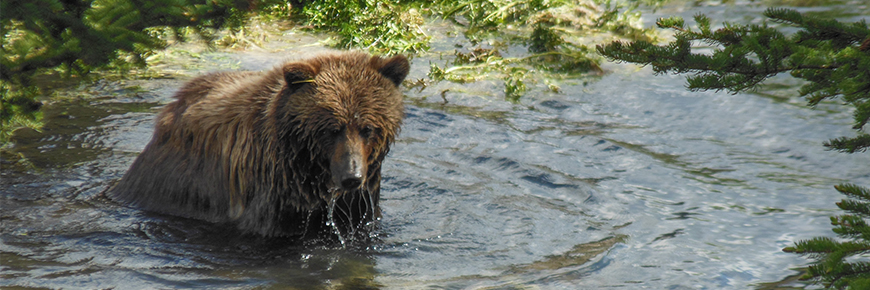
© Chris Mahoney / Parks Canada
Grizzly Bears
Bears in the mountain national parks
Historical Range | Current Status | Threats | Biology | Habitat | Social Behaviour
Historical Range
In North America, grizzly bears (Ursus arctos) once ranged from the Pacific Ocean to the Mississippi River and from Central Mexico to the Arctic Ocean.
Current Status
Today, the prairie population of grizzly bears is locally extinct (extirpated) in Alberta, Saskatchewan and Manitoba. It was extinguished through human intolerance, market hunting, rapid conversion of habitat to agricultural fields, and loss of key prey (buffalo).
It's estimated that up to 20,000 grizzly bears remain in western Alberta, the Yukon and Northwest Territories and British Columbia. The Committee on the Status of Endangered Wildlife in Canada (COSEWIC) lists grizzly bears as a "Special Concern" species due to characteristics that make it particularly sensitive to human activities or natural events. In Alberta, the grizzly bear is designated as threatened, while in British Columbia, it is blue-listed.
The current estimate of the grizzly bear population on provincial lands in Alberta is 691, and up to 16,000 in British Columbia. Within the four contiguous Rocky Mountain national parks, population estimates are:
- Banff National Park: 65
- Jasper National Park: 109
- Yoho National Park: 11-15
- Kootenay National Park: 9-16
Note: many of these bears do not spend their entire lives within the parks.
Threats
Habitat fragmentation and loss caused by an increasing human population is one of the biggest threats to grizzly bear survival, along with accidental human-caused mortality along our transportation corridors (roads and rails).
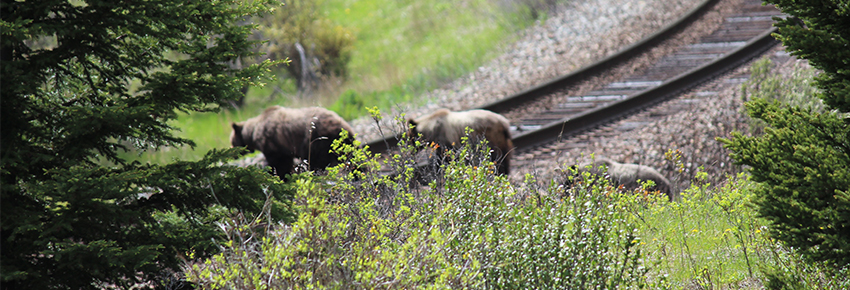
Biology
Grizzly bears have one of the lowest known reproductive rates of all North American land mammals. The age of first reproduction ranges from 5-8 years. A female produces young every 3-5 years. In the mountain parks, research indicates that on average, female grizzly bears have offspring every 4-5 years.
Mating takes place from mid-May to early July. Males will travel long distances to mate with available females. Bred females experience delayed implantation; the embryo does not implant in the uterus until November or December, but only if the bear has enough fat reserves to sustain her and the developing fetuses through hibernation. Female bears going into the den leaner than normal in the fall may emerge in the spring with fewer and/or smaller cubs. This highlights how important habitat quality and diet is to reproductive success.
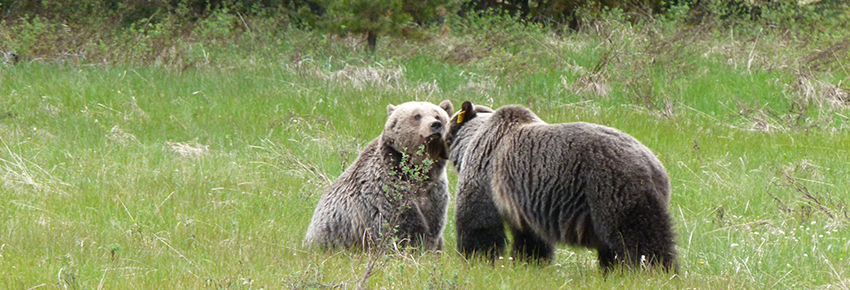
Amorous grizzly bears in Banff National Park
Cubs are born in the den in late January to early February and weigh about half a kilogram (~1 lb). While the female dozes for another several months, the cubs nurse on milk rich in fat. By the time the female emerges from the den with her cubs-of-year, they weigh around 8 kg (18 lbs). A healthy young-of-year cub can weigh up to 45 kg (~100 lbs) by the time the family group dens in the fall.
Offspring typically remain with their mothers for at least three years. During this time, the female nurtures, protects and educates her young, which increases their chances of reaching maturity and reproducing. While under their mother’s care, offspring learn how to forage and move through the landscape to access seasonal habitats. Natural mortality is highest for young-of-year and is usually related to nutrition. Adult male bears sometimes kill offspring. Bears that survive to become mature adults can live 20-30 years in the wild; however, most die human-caused deaths at an earlier age.
Grizzly bears have an excellent sense of smell, and good eyesight and hearing.
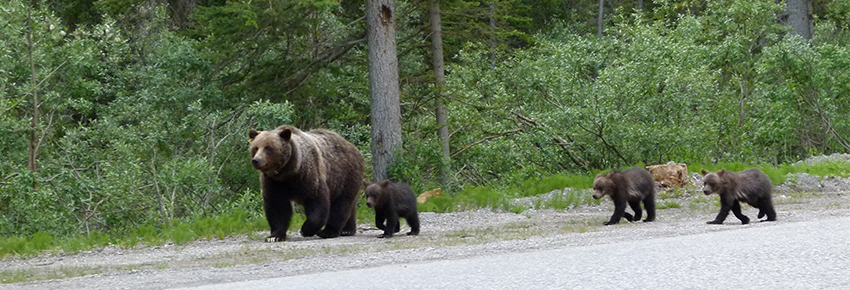
Habitat
Up until the late 1800s, the Canadian prairies were part of the grizzly bear’s home range. This adaptation to open spaces may be why today's Rocky Mountain grizzlies seem well suited to meadow clearings and avalanche paths, where they can more readily detect a threat.
Good grizzly bear habitat includes an adequate seasonal food supply, appropriate denning sites, the presence of some type of cover or shelter, access to mates, and isolation from human disturbance. Since nearly half of the mountain national parks are composed of rock and ice, habitat is fragmented. Consequently, concentrated seasonal food sources and other life requisites are widely dispersed in a patchy distribution that can change from year to year.
Food
Though classified as carnivores, grizzly bears are omnivorous. They selectively eat a variety of plants at specific stages of growth throughout the year; meat constitutes about 15% of their diet. Bears have about seven months to meet their nutritional requirements for the entire year. They must move up and down in elevation and across the landscape to take advantage of these widely scattered food sources.
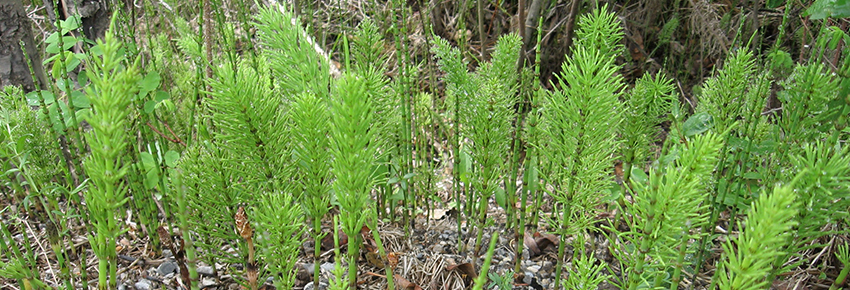
Horsetail
When bears leave their dens in late March to mid-May, food is scarce. Snow lingers at higher elevations. The bears are lean and in need of nutrition. Avalanche chutes and steep sub-alpine grasslands with sunny west and south aspects become snow free first and support a diversity of grasses and flowering plants. Important food sources include the roots of the legume Hedysarum, and the bulbs of glacier lily and spring beauty. Winter-killed wildlife offer an important pulse of protein and fat.
Freshly emerging grasses and sedges in meadows, and along streams and rivers at lower elevations, are also important foods. Introduced plants such as clover and dandelion, which green up early along roadsides and disturbed areas, also provide important forage for bears that will risk human presence associated with such sites.
Grizzly bears typically spend spring in the valley bottoms searching for food and then move to higher elevations as snow disappears and vegetation greens up later in the season. By late spring, horsetail (Equisetum) becomes an important source of food along streams and in wet areas in mature spruce forests. Grizzly bears also prey on newborn calves of elk and other ungulates if the opportunity arises.
By mid-summer, favoured cow parsnip flourishes on avalanche slopes and moist east and north facing slopes near treeline. Bears flip rocks to lick up insects such as ants and ant larvae. Insects are also torn out of rotting logs and trees.
Spring/Early Summer
- Hedysarum roots
- Glacier lily bulbs
- Spring beauty bulbs
- Grasses and sedges
- Dandelion
- Clover
- Cow parsnip
- Horsetail (equisetum)
- Deer, elk or moose calves
- Carcasses of winter-killed ungulates
Late Summer/Fall
- Buffaloberry
- Crowberry
- Bearberry
- Grouseberry
- Currant berries
- Blueberry/huckleberry (west of Great Divide)
- Whitebark pine nuts
- Ants, ant larvae, grubs
- Ground squirrels and marmots
- Deer, elk, bighorn sheep, mountain goats
- Carcasses of elk weakened or injured during the fall rut
- Hedysarum roots (especially if berry crop fails)
By mid-July to early August, the fruits of berry producing shrubs begin to mature. In the Central Rockies, berries are the important high quality food source for bears. They concentrate their efforts where these sun-loving plants flourish—along dry forest edges and in open forest. On the drier east slopes of the Rocky Mountains, buffaloberry is most common. Near the Great Divide and on the moist west slopes of the Rockies, blueberry and huckleberry shrubs also grow. Burned forests are important sites that support berry producing shrubs and Hedysarum.
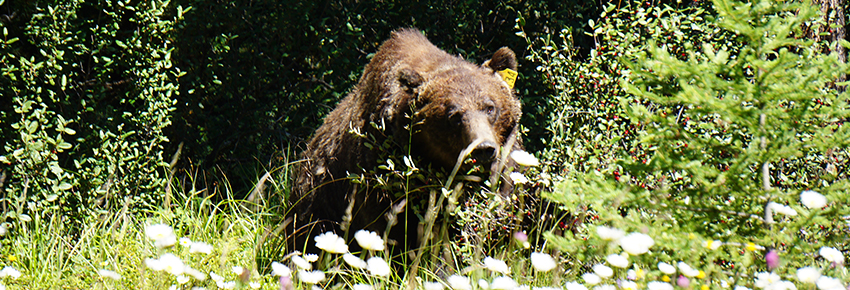
Grizzly bear focused on buffaloberries
Once a hard frost hits, the larger berries drop and bears turn to the tiny berries of low-growing bearberry, crowberry and grouseberry. Whitebark pine nuts stashed in squirrel caches also provide important calories. Ground squirrels, fat after a summer of feeding, are dug out of their burrows. As winter approaches, bears enter a state called "hyperphagia" and may eat for 20-23 hours a day to store enough fat to survive through hibernation.
In some years, the berry crop fails. Bears then rely heavily on Hedysarum roots. They must forage more widely and intensely, using precious energy. With fewer food options and wider travels, food-stressed bears are more likely to get into improperly stored human garbage and other artificial attractants.
Through late fall to hibernation, bears rely once again on Hedysarum roots. Depending on the individual bear and opportunity, ungulates such as elk may become prey.
In the Rocky Mountains, grizzly bears have evolved with dynamic landscape events like fire, avalanche and flood—these natural disturbances cultivate the diverse habitats that bears and many other species rely on.
Shelter or Cover
For grizzly bears, trees and shrubs provide cover for security. Shrubs and forest edge allow females with offspring to stay out of sight and avoid detection and close encounters with dominant bears or people.
Bears also need cover for protection from the weather. Bedding sites (day beds) are generally made near the inside edge of dense forest. Day beds are resting sites that allow bears to maintain a comfortable body temperature on a hot or a cool day.
Grizzly bears have adapted to living in food scarce wintry northern climates by hibernating for up to six months of the year. They dig winter dens into steep slopes with a north or east facing aspect in the sub-alpine where high snow accumulation insulates against the winter cold. Females with cubs are the first to den up, typically in mid-November. Males in particular stay up as long as they have food available to them, which can be well past Christmas.
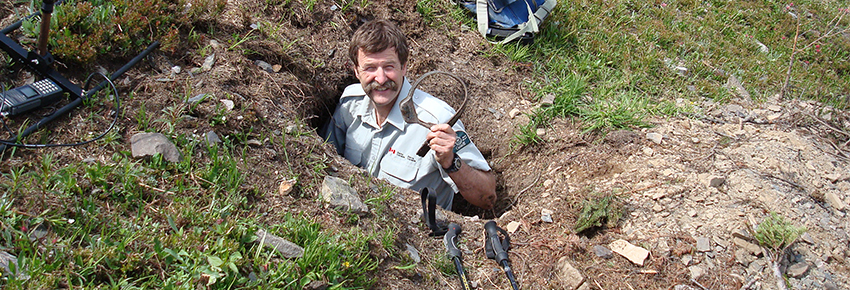
Entrance to a grizzly bear den in the subalpine
Space
Bears select and use habitats based on social interactions with other bears and the presence or absence of human activity. Grizzly bears are not territorial but establish home ranges that vary in size depending on the individual bear and habitat quality. Home ranges may overlap and are usually not aggressively defended.
Although the size of home ranges may vary greatly, the average home range in the Central Rockies is:
- Males: 1000-2000 km2
- Females: 200-500 km2
To survive and successfully raise their young, adult female bears need safe, predictable, quality habitat within their home ranges. Female offspring establish their home range in the vicinity of their mother, but males usually travel or disperse farther away.
Social Behaviour
Grizzly bears are solitary animals, except when with offspring or a mate. Their large body size and the patchy, widespread nature of their food sources keep bears at a low density. However, bears will warily tolerate each other at concentrated food sources like a coastal salmon stream or a large patch of ripe berry bushes. At such times, body postures, facial expression and vocalization help out individual bears and reduce the chance of confrontations that could result in serious injury. Grizzly bears will defend their own individual space, their cubs, and food.
The fact that grizzly bears once lived in a prairie landscape may explain some of their behaviour when threatened. On the prairies, grizzlies lacked areas of shelter for retreat, so became accustomed to standing their ground when confronted. Grizzly bears are more likely to defend themselves when surprised and seem to have a more aggressive temper than black bears.
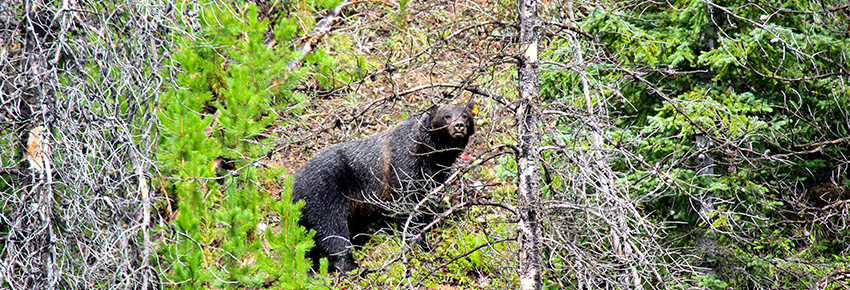
Grizzly bear guarding an elk carcass
Rub trees (trees that generations of bears repeatedly rub and scratch), droppings and urine also communicate a bear's presence and perhaps social status. Social status is generally based on size as a reflection of sex and age. Adult male bears tend to be dominant. Dominant bears have the pick of the best habitat and food sources. Generally in this social ranking, after mature males, mature females with offspring follow, then single adult bears, and at the bottom of the social ladder, sub-adult (teenage) bears.
Click here to see how important rub trees are to a bear's social network.
Once independent of their mother, sub-adult bears must establish their own home ranges and fit into the landscape. These bears are curious and on a learning curve. On an evolutionary scale, this curious behavior probably helped bears find food in a wide variety of landscapes. Today, it also makes young bears vulnerable to danger from humans. Young, naive bears are more likely to tolerate people in order to access high quality habitat near human activity and developments; consequently, they are more likely to die a human-caused death.
Females with offspring are also more likely to use habitat near people, both to avoid dominant males that pose a threat to their young, and to access much needed natural bear foods. Bears using habitat near people often forage at night or early and late in the day when human activity is typically low. This avoidance behaviour helps prevent bear-human conflict, but usually with an energetic cost to the bear. If there are no good or bad consequences, the avoidance response can wane as the bear becomes more and more tolerant of human activity. They become bolder or less wary around people.
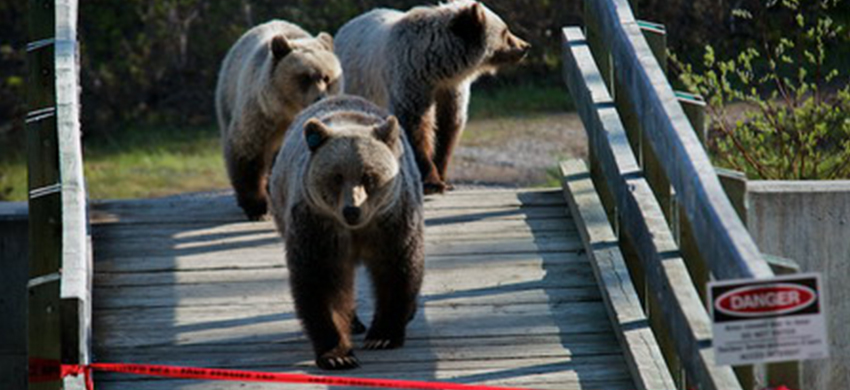
This grizzly bear family uses habitat on the fringes of the hamlet of Lake Louise
©Alex Taylor
The need to provide secure quality habitat where adult female bears and their offspring can forage on a daily basis with minimal human disturbance is vital to maintain wary bear behaviour, and the health of the regional bear population. It takes a big land base to support a self-sustaining population of grizzly bears; even the mountain national parks do not provide enough habitat by themselves. Cross-boundary cooperation and management is essential.
Related links
- Date modified :